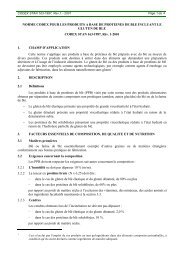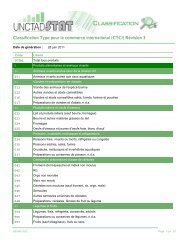issues and constraints related to the development of cashew nuts ...
issues and constraints related to the development of cashew nuts ...
issues and constraints related to the development of cashew nuts ...
Create successful ePaper yourself
Turn your PDF publications into a flip-book with our unique Google optimized e-Paper software.
31. IntroductionThe purpose <strong>of</strong> this paper is <strong>to</strong> give an overview <strong>of</strong> <strong>constraints</strong> <strong>and</strong> opportunities for <strong>cashew</strong>export <strong>development</strong> in five West African countries, namely Côte d’Ivoire, Ghana, Guinea Bissau,Guinea <strong>and</strong> Nigeria.This paper is based on two surveys1 conducted in 1999 <strong>and</strong> in 2001, <strong>and</strong> funded by funded by <strong>the</strong>USAID, in <strong>the</strong> framework <strong>of</strong> <strong>the</strong> Sustainable Tree Crops Program (STCP). The aim <strong>of</strong> <strong>the</strong>Sustainable Tree Crops Program is “<strong>to</strong> improve <strong>the</strong> well-being <strong>of</strong> smallholder farmers, through<strong>the</strong> <strong>development</strong> <strong>of</strong> sustainable tree crop systems that increase productivity, generate income,conserve biodiversity, use natural resources in a sustainable manner <strong>and</strong> <strong>of</strong>fer stable <strong>development</strong>prospects <strong>and</strong> long-term economic incentives”. The program focuses on 3 tree crops, namely<strong>cashew</strong>, cocoa <strong>and</strong> c<strong>of</strong>fee.Data for individual countries are only presented in <strong>the</strong> form <strong>of</strong> general conclusions, or with aview <strong>to</strong> illustrate a specific points, as much <strong>of</strong> <strong>the</strong> findings <strong>of</strong> <strong>the</strong> two studies are on <strong>the</strong> wholesimilar.The two surveys were based on:- The analysis <strong>of</strong> detailed questionnaires completed by various research institutes;- Field visits made by <strong>the</strong> teams, during which thous<strong>and</strong>s <strong>of</strong> trees were inspected <strong>and</strong>observed at <strong>the</strong> time <strong>of</strong> panicle production, flowering <strong>and</strong> nut set in differentregions in <strong>the</strong> five countries surveyed. This time period was <strong>the</strong> most critical withregard <strong>to</strong> production <strong>of</strong> <strong>nuts</strong> <strong>and</strong> apples. It was also <strong>the</strong> time when pests <strong>and</strong>diseases were at <strong>the</strong>ir most damaging. Naturally <strong>the</strong>re may have been o<strong>the</strong>r pests<strong>and</strong> diseases that occurred at o<strong>the</strong>r times <strong>of</strong> <strong>the</strong> year, but <strong>the</strong>ir effect would havebeen mainly on vegetative production. Fortunately <strong>cashew</strong> trees can withst<strong>and</strong>substantial damage <strong>to</strong> leaves, before <strong>the</strong>re is a reduction in yield. It is also almostcertain that pest populations will vary in intensity from year <strong>to</strong> year <strong>and</strong> place <strong>to</strong>place;- Discussions with farmers, extension workers, processors, traders, etc.2. Production <strong>constraints</strong>2.1 Biotic <strong>constraints</strong> Insect pestsDamage from <strong>the</strong> different insect species, albeit at different levels <strong>of</strong> seriousness, was generallywidespread throughout all <strong>the</strong> countries surveyed. Even though, perhaps, a particular insect pestspecies was not a problem in one country at <strong>the</strong> time <strong>of</strong> <strong>the</strong> survey, many insect pests have <strong>the</strong>1 “Assessment <strong>of</strong> Options <strong>and</strong> Opportunities for Tree Crop Development in East <strong>and</strong>West/Central Africa” by Dr. Clive P. Topper <strong>and</strong> Pr<strong>of</strong>essor Peter Caligari, 1999, <strong>and</strong>“West Africa Regional Cashew Survey (covering <strong>the</strong> countries Guinea, Guinea Bissau,Cote d’Ivoire, Ghana <strong>and</strong> Nigeria), Volume 1”, by Dr. Clive P. Topper, Pr<strong>of</strong>. PeterCaligari, Dr. Mahmoud Camara, Mr. Souret Diaora, Mr. Akadie Djaha, Dr. FelixCoulibaly, Dr. A. K. Asante, Dr. Adomako Boamah, Mr. E. Akin Ayodele, Mr. Patrick O.Adebola, 2001.


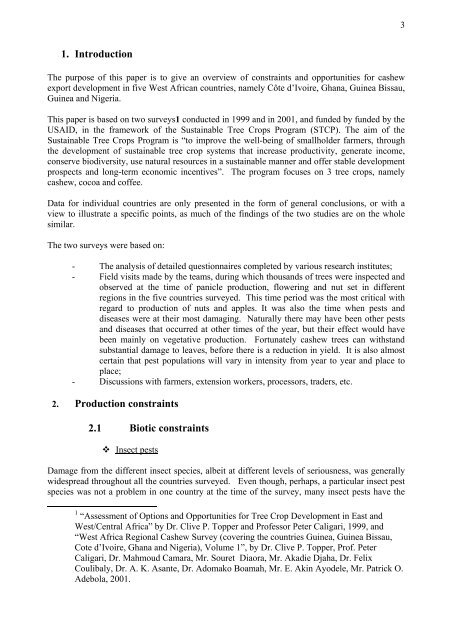
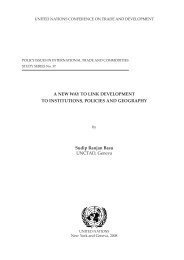

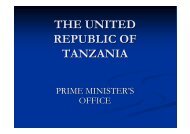
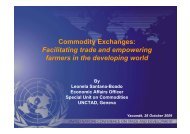
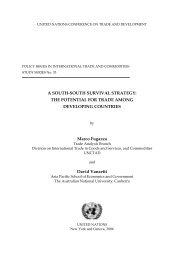
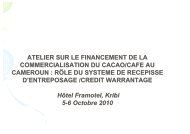
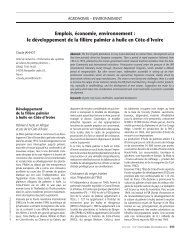
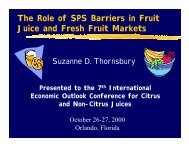
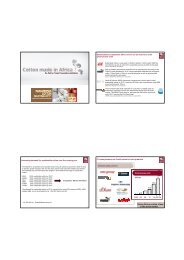
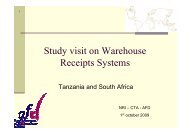
![Warehouse Receipt Systems: Legal Issues [PDF]](https://img.yumpu.com/43979338/1/190x134/warehouse-receipt-systems-legal-issues-pdf.jpg?quality=85)
